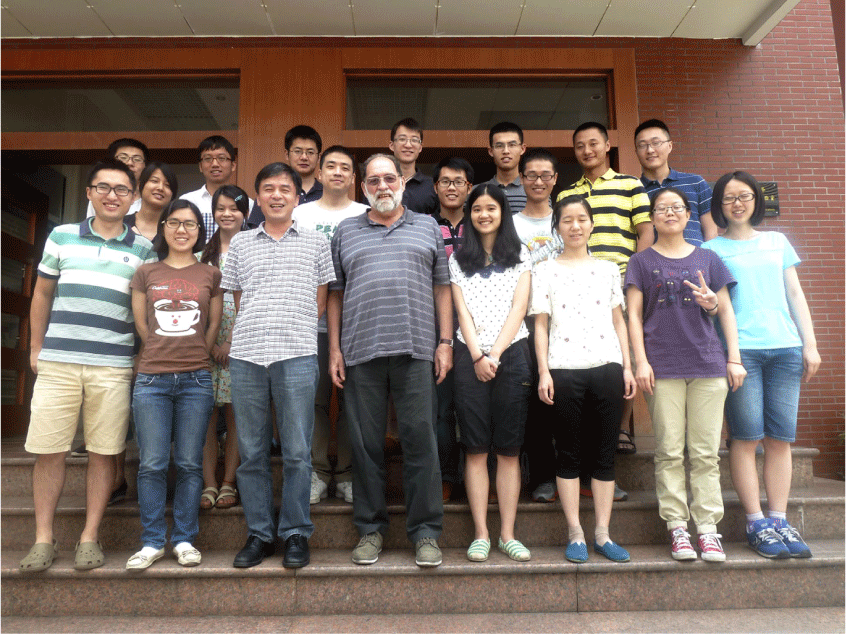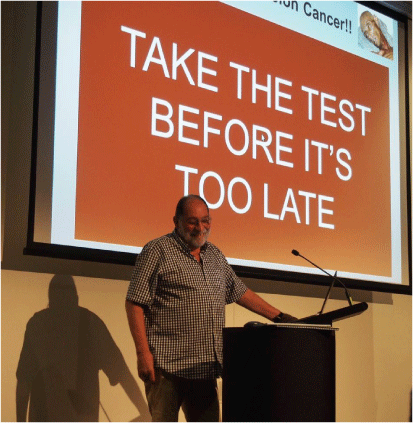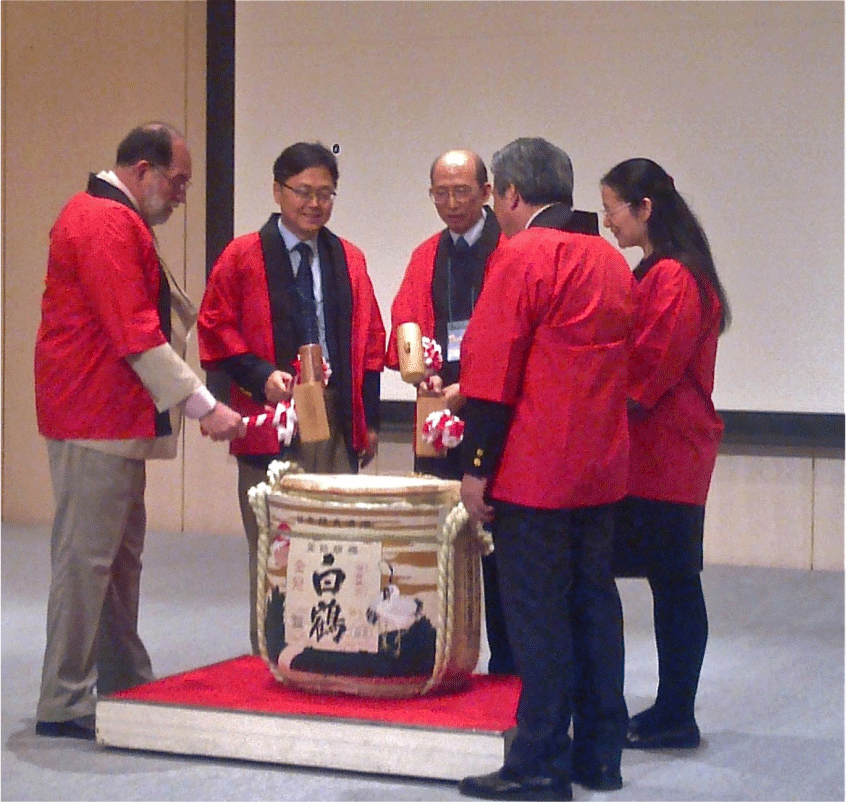Professor Edouard Nice
John D. Wade A * and Marie-Isabel Aguilar
A * and Marie-Isabel Aguilar  B *
B *
A Florey Institute of Neuroscience and Mental Health, University of Melbourne, Melbourne, Vic. 3010, Australia.
B Department of Biochemistry and Molecular Biology, Monash University, Clayton, Vic. 3800, Australia.

John D. Wade obtained his PhD in Biochemistry in 1980 at Monash University, Australia. He then received a Nuffield Foundation Fellowship to Cambridge, UK, at the MRC Laboratory of Molecular Biology working with R. C. Sheppard on modern methods of chemical peptide synthesis. In 1983, he returned to Australia to the Howard Florey Institute, the now Florey Institute of Neuroscience and Mental Health, University of Melbourne, where he has long headed the Laboratory of Peptide and Protein Chemistry. His interests are in chemical peptide synthesis of complex, functionalised peptides including antimicrobial peptides. Prof. Wade is a past NHMRC of Australia Principal Research Fellow and a Fellow of both the Royal Australian Chemical Institute and the Royal Society of Chemistry. |

Prof. Marie-Isabel (Mibel) Aguilar is a Bioanalytical and Biophysical Chemist at Monash University whose research focuses on biomembrane nanotechnology, peptide biomaterials and peptidomimetic drug design. She completed her PhD in Chemistry at the University of Melbourne studying the metabolism and toxicity of paracetamol. She then completed a post-doctoral position at St Vincent’s Institute for Medical Research working on developing physical models for protein analysis and purification. She then moved to Monash University where her group focuses on peptide-based biomaterials, drug design and biomembrane nanotechnology and are developing novel compounds that allow us to exploit the potential of peptides as drugs and biomaterials. |
Handling Editor: George Koutsantonis
Australian Journal of Chemistry 76(8) 311-317 https://doi.org/10.1071/CH23094
Submitted: 16 May 2023 Accepted: 17 May 2023 Published: 11 August 2023
© 2023 The Author(s) (or their employer(s)). Published by CSIRO Publishing.
We are delighted to introduce this Special Issue of the Australian Journal of Chemistry to mark the 75th birthday of Prof. Edouard Nice who heads up the Clinical Biomarker Discovery and Validation group, Department of Biochemistry and Molecular Biology, Monash University. The issue comprises 19 manuscripts contributed by highly respected, long-time colleagues and collaborators from five different countries that address a remarkably wide and diverse range of key subjects of peptide and protein chemistry and biology, which have long been the foundation of Ed’s research.
Papers in this special issue have been grouped according to paper type, starting with seven Review papers, followed by one Highlight and one Account paper, and closing with ten Research Papers. First of the Review papers is that of Hao et al.[1] at the China Pharmaceutical University, Nanjing, who review peptide–drug conjugates (PDCs), which are an emerging targeted therapeutic drug following on from the relative success of antibody–drug conjugates. Jin, Li and colleagues[2] from the Sichuan University report on nanotechnology as an emerging as a powerful tool to achieve specific targeting, non-invasive therapeutics, high therapeutic efficiency and improved drug sensitivity for cancers by exploiting the features of their microenvironment, especially the redox properties. Smith and Matthews[3] of the University of Sydney review the events leading to co-clustering of transcriptional proteins with other factors in vivo, forming multivalent dynamic clusters that contribute to controlled RNA transcription. Denton and Cooper[4] of the Washington State University Health Sciences Spokane and the New York Medical College describe the metabolic importance of the glutaminase II (GTωA) pathway in microorganisms, plants and mammals and its corollary importance in agriculture and cancer research. Browne[5], also of Monash University, provides brief review of the history and chemistry of printing, centred around the life and inventions of Johannes Gutenberg, who is widely regarded as the father of printing. Hunter, of SCIEX USA, and colleagues[6] highlight some of the diverse biological applications that use DIA-MS methods, including large-scale quantitative proteomics, post-translational modification studies, single-cell analysis, food science, forensics, and small molecule analysis. In the last Review, Huang et al.[7] briefly review the Hippo signalling pathway and the relationship between Hippo inactivation and cancer development, and highlight the potential use of chemicals targeting Hippo signalling in cancer treatment.
In their Highlight paper, Gregg and Caine[8] of Davies Collinson Cave, Australia, provide an important outline the requirements for natural product patent eligibility in Australia, the US and Europe. Bradshaw[9] of the University of California—Irvine then presents an erudite Account paper on the development of methods and strategies that principally characterise the field of proteomics and that have depended heavily on the evolution of those that advanced protein chemistry.
In the first Research Paper in this collection, Skwarczynski, Zhao and colleagues[10] at the University of Queensland show that polyphenylalanine acts as a self-adjuvanting moiety when conjugated to a peptide antigen derived from Group A Streptococcus M-protein. Lipidation of the polyphenylalanine moiety enabled the conjugate to form nanoparticles. Sun, Chen et al.[11] from the Beijing Institute of Lifeomics report on the application of the representation learning method to the joint analysis of biomedical network and omics data to aid the pathogenesis, prognosis prediction and treatment strategies of cancers. Lucas-Valmalle and colleagues[12] from CNRS-Université Montpellier describe the structure-activity relationship of a neuropeptide called acein that stimulates dopamine release in the brain of rodents in vivo and ex vivo by interacting with angiotensin converting enzyme (ACE). Li, Handley and coworkers[13] from The University of Melbourne show the strategy of chemically directed dimerisation of antimicrobial peptides is a useful means of producing potentially more therapeutically useful antimicrobial agents. Zhang, Dong et al.[14] from Sichuan University report on the identification of NQO1 as a molecular target of the natural product, agrimol B, which provides a new insight into the anti-cancer mechanism of agrimol B in hepatocellular carcinoma. Moh and coworkers[15] at Macquarie University describe the phenotyping of patients with CHST3-related skeletal dysplasia by profiling the glycosaminoglycans and identifying their potential protein carriers sequentially using freezer-induced patient urine sediments. Lee and coworkers[16] at Monash University describe their studies on the use of alpha–beta-peptide mimetics to confirm the presence of an RRR motif significantly enhanced the ability of the peptides to bind to and insert into the mitochondrial membrane mimic, thus providing insights into the role of selective membrane targeting of peptides. Ismail et al.[17] of the University of Wolverhampton describe a multi-stage process to develop a reliable machine learning predictor of cell penetrating peptides. Finally, in a pair of Research Paper contributions, Wang of Curandis in Boston and Roehrl of the Harvard Medical School and colleagues[18,19] describe an autoantigen-ome study that provides a comprehensive molecular map for investigating acute, subacute and chronic autoimmune disorders caused by SARS-CoV-2 (COVID-19) and an approach to the development of a vaccine.
These contributions reflect the impact that Ed’s work has had across many of these subjects as well as to the garnering of a lifetime of friends and colleagues who embrace chemistry.
After finishing his schooling at Emanuel School, Wandsworth Common, London, Ed studied at South London College from 1969 to 1972, where he was awarded a Licentiate of the Royal Institute of Chemistry with an Endorsement in Advanced Analytical Chemistry. In 1972, he joined the Chester Beatty Research Institute, London, as a Technical Officer where he completed his PhD thesis on ‘HPLC analysis of steroid hormones in adrenal and testicular cancer’ (enrolled at Sir John Cass College, University of London) in 1975. He was elected Fellow of The Chemical Society (FRSC), London in 1973 and a Member of the Institute of Science and Technology UK (MIST) in 1974.
His long-term research interests have been in protein and peptide micropurification, biomarker discovery and validation, surface plasmon resonance (SPR) analysis, high throughput monoclonal antibody production and validation, and clinical biomarker assay development, with a strong translational focus on colorectal cancer, especially the development of faecal proteomics for colorectal cancer detection and surveillance. At the Chester Beatty, he was originally employed in the Department of Biochemistry, working with Prof. Eric Boyland (a founding father of molecular toxicology) on the analysis of carcinogens in food and drink. In 1970, following the retirement of both Prof. Boyland and the then director, Prof. Sir Alexander Haddow (one of Ed’s early mentors), a new director, Prof. Sir Tom Symington, who was an expert in adrenal and testicular cancer, was appointed. It was suggested that Ed join with Prof. Munro Neville, the new Associate Director, who had come from Scotland with Prof. Sir Tom Symington to set up an Endocrine Tumour Pathology Group. Ed’s role was to develop novel analytical techniques (micropreparative GC and the emerging high resolution separation technology of HPLC) for the detection and measurement of steroid hormones in adrenal and testicular tissues, to understand the associated tumour biology and find potential biomarkers. In 1975, in a clever move by Prof. Sir Tom Symington to avoid major budget cuts across the board by the Medical Research Council (MRC), the first of several Ludwig Institutes of Cancer Research (LICRs) was established (initially at the Chester Beatty site in Fulham Rd and then at the newly established facility at the Royal Marsden Hospital in Sutton), under the directorship of Prof. Neville. Ed played a major role in the establishment of both sites and was, in fact, both the first, and longest employed, scientific staff member of the LICR with a total tenure of almost 35 years. In what was to prove a curious twist of fate (see later), he also developed methods for the purification of murine epidermal growth factor (EGF) from murine salivary glands, not for research purposes, but to reduce the cost of this protein for the extensive tissue culture being carried out at the Institute! Aside from science, one of his other passions was rugby, and he was often introduced by Sir Alexander Haddow to visitors as ‘our rugby player’. By chance, this passion was translated into an opportunity to raise funds for cancer research. He and Prof. Tom Connors, the then director of the MRC Toxicology Unit in Sutton, were approached by a French journalist from Beziers, Henri Devos, who had established an organisation known as FISMARC (Federation Internationale du Sport Médical pour l’Aide à la Recherche Contre le Cancer) to raise funds for cancer research, to put together a British Medical 15. Four games were played in Beziers, Cardiff, Paris and London (Fig. 1).
In 1980, largely due to the financial chaos in the UK associated with the Thatcher Government, Ed decided on a major sea change and emigrated to Melbourne, Australia. Many of his scientific colleagues said he was crazy, but with the benefit of hindsight, it had a major, and very positive effect on his career. He was recruited by Prof. Tony Burgess, the Director of the LICR group in Melbourne, helped establish the laboratories there, and was made an LICR Associate Member and Head of the Protein Biosensing Laboratory. An early focus of his work in Melbourne was on the continued development of multidimensional HPLC methods for the purification of peptides and proteins, and micropreparative HPLC using short (3 cm) microbore (2.1- and 1.0-mm internal diameter) columns to prevent the unacceptable losses observed with conventional (4.6-mm internal diameter) columns. These methods were successfully employed in collaboration with scientists at the Walter and Eliza Hall Institute (Melbourne), The Royal Melbourne Hospital and CSIRO, for the purification and N-terminal sequence analysis of granulocyte–macrophage colony stimulating factor (GM-CSF), granulocyte (G-)CSF, macrophage (M-)CSF and leukemia inhibitory factor (LIF) (Fig. 2). In particular, GM-CSF and G-CSF proved of great economic benefit to Australia, with the world market for CSFs in 2008 being in excess of US$4 billion. The opera singer, Jose Carerras, credits the CSF treatment he received at the Royal Melbourne Hospital in 1987 with saving his life from acute myeloid leukaemia. Another major focus was on the structure and function of EGF and the EGF receptor (EGFR) families, which play a major role in driving abnormal cell growth in many cancers. This led to the development of both small molecule (AG1478) and antibody-based (e.g. Mab 806, huAb A33) therapeutics. In 2009, because of the impending closure of the Melbourne branch due to the massive losses LICR had incurred due to The Black Friday stock market crash and 9/11 (LICR was one of the ‘Names’ at Lloyds), Ed was recruited by Monash University to help establish and run the Monash Antibody Technologies Facility (MATF), one of the first roboticised high-throughput monoclonal antibody facilities in the world.
The LICR–CSIRO team involved in cloning mouse granulocyte–macrophage colony-stimulating factor (GM-CSF). Back row: Nick Gough, Tony Burgess, Ed Nice and Ashley Dunn (all from LICR). Front Row: Diane Grail (LICR), Jill Gough (LICR) and Lindsay Sparrow (CSIRO). Source: reproduced with permission from AlphaMed Press.
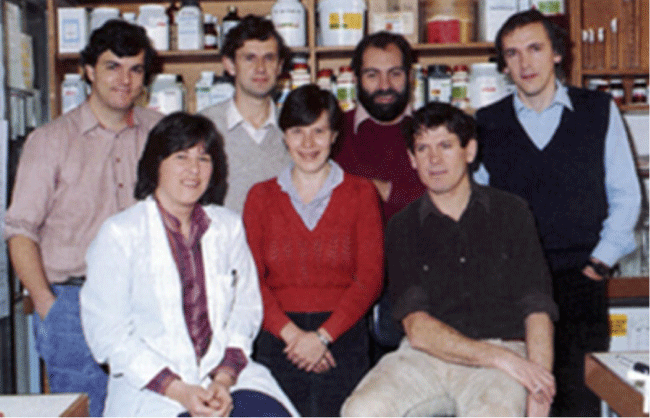
Although he officially retired in 2013, he has continued his research mainly with groups at Macquarie University (Adjunct Professor, 2016–2019) and Sichuan University, China (Visiting Professor, 2013–current) (Fig. 3). This has enabled him to further his studies on oncoproteomics and personalised medicine. His long-term interaction with Prof. Huang at Sichuan University has been particularly rewarding and has resulted in over 90 publications. During his visits to Chengdu, he has also interacted with The Chengdu Research Base of Giant Panda Breeding and The Animals Asia Moon Bear Rescue Centre to advise on suitable assays to monitor the animals’ wellbeing (Fig. 4).
Helping protect the Chinese wildlife. (a) Asia Moon Bear Rescue Centre in Chengdu, and (b) Chengdu Research Base of Giant Panda Breeding.
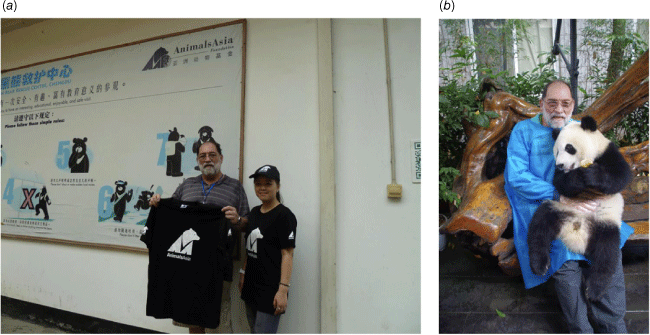
Ed has had several productive commercial interactions including Beckman–Altex (columns for RP-HPLC of proteins and peptides), Pharmacia (development of the SMART micropreparative HPLC system), BIAcore (development and application of BIAcore SPR biosensor technology) and Ciphergen (SELDI (surface-enhanced laser desorption–ionisation) MS). He was scientific advisor to Sienna Cancer Diagnostics (developing a telomerase biosensor that was their original platform) and SynThesis, a Melbourne-based company supplying contract chemical synthesis out of China.
He has authored over 350 peer-reviewed publications in many high-quality journals, with over 24 000 citations and an h-index of 85. He holds or has held 13 patents in related areas. He is a pioneer in the field of faecal proteomics for the early detection of colorectal cancer and, indeed, coined the term ‘The Turdome’ in a lecture at the 7th Australian Peptide Conference–4th International Peptide Symposium in Cairns in 2007. He was awarded the Xiaoyu Hu Memorial Award by the Chinese Peptide Society in 2012 in recognition of his significant achievements in the field of peptide science. Following a landmark US tax ruling in 1997 concerning the Howard Hughes Medical Institute, researchers at LICR were able to apply for external grants. Between then and 2013, Ed and co-workers successfully obtained more than US$6 million in funding.
He is a founding member of the Australian Peptide Association (Treasurer 1994–2001, Vice Chairman, 2001–2007 and Steward, 2007–2017) as well as the Peptides and Proteins Society of Singapore. He has had a long association with the Lorne Conferences being on the Lorne Protein Conference committee for several years and Steward of the Lorne Cancer Conference (1992–2002). He was also a co-ordinator of the Electronic Lorne Cancer Conference, which was trialled in 1997 and 1998. In this initiative, one of the first of its kind in the world, the talks were captured electronically and linked to the corresponding audio so that delegates could attend in a ‘virtual’ manner on their laboratory PC, a forerunner of the virtual conferences we have become used to during the COVID-19 pandemic. He was on the Program Committee of the 13th International Symposium on Regulatory Peptides (Cairns, Australia, 2000), the organising committee of a series of specialist workshops on ‘The Use of Biosensor Technologies for the Study of Macromolecular Interactions’ (1997–2001), and Chair of the Omics Revolution meetings held recently in conjunction with the Australian Peptide Conferences. He is actively involved in the Human Proteome Organization (HUPO), was co-chair and treasurer of the successful HUPO 2010 meeting in Sydney, and is currently co-chair of the Pathology Pillar, co-chair of the Human Cancer Proteome Project and leader of the HUPO ANZ Chromosome 7 initiative. He has been invited to speak at numerous conferences, especially in the areas of peptide chemistry, chromatography, biosensors, proteomics, cancer research, and personalised and precision medicine (Fig. 5–6).
Ed has served on the editorial boards of several scientific journals including Executive Editor for Analytical Biochemistry, Associate Editor for Frontiers in Medicine and is or has been Editor or on the Editorial Board for Biomedical Chromatography, Expert Review of Proteomics, Molecular and Cellular Proteomics, Journal of Proteomic Research, Current Signal Transduction Therapy, Clinical Proteomics and Growth Factors. In 2004, he was cited as an Analytical Biochemistry Top 10 Reviewer.
He has been involved in several educational initiatives during his career. While Associate Director of the CRC for Cellular Growth Factors (1995–2004), he was Chair of Education and Training. During that time, the Undergraduate Research Opportunities Program (UROP), a new initiative (introduced into Australia by Prof. Doug Hilton, who had become aware of the concept while doing a postdoc at MIT in the US) designed to encourage bright undergraduates to continue to a PhD, was introduced to Melbourne University, associated institutes and CSIRO. He also introduced an International Masters Student Exchange Program to enable students in Biotechnology from European universities to do the industrial training component of their studies at the LICR or CSIRO. Participating universities included the University of Uppsala, Sweden, University of Applied Science, Mannhein, Germany, and Ecole Superieure de Biotechnologie, University of Strasbourg, France. He has supervised many Honours, Master, PhD and MD students, and has been an external examiner for a number of PhD theses. He is currently working with the Royal Australasian College of Pathologists (RACP) to develop workshops to introduce pathologists and clinicians to proteomics and its role in personalised medicine.
On behalf of his many friends, colleagues, collaborators and students, past and present, both national and international, we salute Ed’s 75th birthday and look forward to his continued interaction and friendship with his many scientific associates worldwide, attendance at his favourite scientific meetings, and his mentoring of the current and next generation of peptide and protein chemists. Ed has been, and continues to be, a true scientific giant in the field of peptide and protein chemistry and we look forward many more years of sustained contributions to come.
Conflicts of interest
John D. Wade is an editor for Australian Journal of Chemistry but did not at any stage have editor-level access to this manuscript while in peer review, as is the standard practice when handling manuscripts submitted by an editor to this journal. Australian Journal of Chemistry encourages its editors to publish in the journal and they are kept totally separate from the decision-making processes for their manuscripts. The authors have no further conflicts of interest to declare.
References
1 Hao C, Chen P, Zhang H, Setrerrahmane S, Xu H. ‘Renovation of old drugs’ – can peptide drug conjugates lead the post-ADC era? Aust J Chem 2023; 76: 318-336.
| Crossref | Google Scholar |
2 Jin P, Li L, Nice EC, Huang C. Nanomedicine-based modulation of redox status for cancer therapy. Aust J Chem 2023; 76: 337-350.
| Crossref | Google Scholar |
3 Smith NC, Matthews JM. DNA-binding, multivalent interactions and phase separation in transcriptional activation. Aust J Chem 2023; 76: 351-360.
| Crossref | Google Scholar |
4 Denton TT, Cooper AJL. Chemistry, biochemistry and clinical relevance of the glutamine metabolite α-ketoglutaramate/2-hydroxy-5-oxoproline. Aust J Chem 2023; 76: 361-371.
| Crossref | Google Scholar |
5 Browne C. Gutenberg, chemistry and the advancement of knowledge. Aust J Chem 2023; 76: 372-378.
| Crossref | Google Scholar |
6 Hunter CL, Bons J, Schilling B. Perspectives and opinions from scientific leaders on the evolution of data-independent acquisition for quantitative proteomics and novel biological applications. Aust J Chem 2023; 76: 379-398.
| Crossref | Google Scholar |
7 Huang Z, Tan Y, Zhang W, Tang X, Nice EC, Huang C. Hippo signaling in cancer: regulatory mechanisms and therapeutic strategies. Aust J Chem 2023; 76: 399-412.
| Crossref | Google Scholar |
8 Gregg C, Caine MJ. Navigating natural product-related patents in Australia and beyond. Aust J Chem 2023; 76: 413-417.
| Crossref | Google Scholar |
9 Bradshaw RA. On the development of proteomics: a brief history. Aust J Chem 2023; 76: 418-428.
| Crossref | Google Scholar |
10 Skwarczynski M, Zhao G, Ozberk V, Giddam AK, Khalil ZG, Pandey M, Hussein WM, Nevagi RJ, Batzloff MR, Capon RJ, Good MF, Toth I. Polyphenylalanine as a self-adjuvanting delivery system for peptide-based vaccines: the role of peptide conformation. Aust J Chem 2023; 76: 429-436.
| Crossref | Google Scholar |
11 Sun D, Chen R, Ma S, Zhang Y, Li D. Implementation of network embedding strategy on proteome datasets from multi-source cancers to demonstrate marker proteins of cancers. Aust J Chem 2023; 76: 437-447.
| Crossref | Google Scholar |
12 Lucas-Valmalle C, Subra G, Verdié P, Kemel M-L, Daugé V, Puget K, Martinez J. The C-terminal pentapeptide acein analogue (JMV3315) stimulates dopamine release in the brain. Aust J Chem 2023; 76: 448-454.
| Crossref | Google Scholar |
13 Li R, Handley TNG, Li W, O’Brien-Simpson NM, Hossain MA, Wade JD. Directed chemical dimerisation enhances the antibacterial activity of the antimicrobial peptide MSI-78(4–20). Aust J Chem 2023; 76: 455-464.
| Crossref | Google Scholar |
14 Zhang D, Dong L, Yang W, Wang K. Identification of NQO1 as a target of herbal drug agrimol B in hepatocellular carcinoma. Aust J Chem 2023; 76: 465-475.
| Crossref | Google Scholar |
15 Moh ESX, Zankl A, Packer NH. Phenotyping CHST3 skeletal dysplasia from freezer-induced urine sediments. Aust J Chem 2023; 76: 476-781.
| Crossref | Google Scholar |
16 Lee T-H, Checco JW, Malcolm T, Eller CH, Raines RT, Gellman SH, Lee EF, Fairlie WD, Aguilar M-I. Differential membrane binding of α/β-peptide foldamers: implications for cellular delivery and mitochondrial targeting. Aust J Chem 2023; 76: 482.
| Crossref | Google Scholar |
17 Ismail B, Jones S, Howl J. A holistic approach towards a generalizable machine learning predictor of cell penetrating peptides. Aust J Chem 2023; 76: 493-506.
| Crossref | Google Scholar |
18 Wang JY, Zhang W, Roehrl MW, Roehrl VB, Roehrl MH. An autoantigen profile from Jurkat T-Lymphoblasts provides a molecular guide for investigating autoimmune sequelae of COVID-19. Aust J Chem 2023; 76: 508-524.
| Crossref | Google Scholar |
19 Wang JY, Zhang W, Roehrl VB, Roehrl MW, Roehrl MH. An autoantigen-ome from HS-Sultan B-Lymphoblasts offers a molecular map for investigating autoimmune sequelae of COVID-19. Aust J Chem 2023; 76: 525-557.
| Crossref | Google Scholar |



